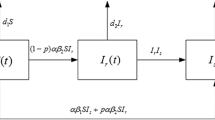Abstract
In this paper a mathematical model is proposed for the interaction of the immune system with HIV viruses and malaria parasites in an individual host. It consists of a system of three coupled ordinary differential equations, which represents the rate of change in the concentration of malaria parasites, HIV viruses and immunity effector within a host, respectively. The theoretical model gives insight into the biological balance between pathogen replication and the immune response to the pathogen: persistence versus elimination of the pathogen, which determines the outcome of infection. Dynamical analysis shows that the outcomes of the interactions between the immune system of the host with either malaria parasites or HIV viruses are dramatic such as malaria infection promoting proliferation of HIV virus, HIV infection increasing the risk from malaria and the immune system of the host failing to keep the diseases under control, etc. The results provide a new perspective for understanding of the complexity mechanisms of the co-infection (or dual infection) with malaria and HIV in a host.
Similar content being viewed by others
References
Abu-Raddad, J.L., Patnaik, P., Kublin, G.J., 2006. Dual infection with HIV and Malaria fuels the spread of both diseases in Sub-Saharan Africa. Science 314(8), 1603–1606.
Bloland, P.B., Wirima, J.J., Steketee, R.W., et al., 1995. Maternal HIV infection and infant mortality in Malawi: evidence for increased mortality due to placental malaria infection. AIDS 9, 721–726.
Chirenda, J., Siziya, S., Tshimanga, M., 2000. Association of HIV infection with the development of severe and complicated malaria cases at a rural hospital in Zimbabwe. Centr. Afr. J. Med. 46, 5–9.
Diekmann, O., Heesterbeek, J.A.P., Metz, J.A.J., 1990. On the definition and the computation of the basic reproduction ratio R 0 in models for infectious diseases in heterogeneous populations. J. Math. Biol. 28, 365–382.
Francesconi, P., Fabiani, M., Dente, M.G., et al., 2001. HIV, malaria parasites, and acute febrile episodes in Ugandan adults: a case-control study. AIDS 15, 2445–2450.
French, N., Lugadda, E., Watera, C., Nakiyinga, J., Carpenter, L., Gilks, C.F., 1998. Falciparum malaria and its association with immune status in a cohort of HIV-1 infected adults in Entebbe, Uganda. In: 12th World AIDS Conference, Geneva, 28 June–3 July.
Grimwade, K., French, N., Mbatha, D.D., et al., 2004. HIV infection as a co-factor for severe falciparum malaria in adults living in a region of unstable malaria transmission, South Africa. AIDS 18, 547–554.
Khasnis, A.A., Karnad, D.R., 2003. Human immunodeficiency virus type 1 infection in patients with severe falciparum malaria in urban India. J. Postgrad. Med. 49, 114–117.
Kublin, J.G., Patnaik, P., Jere, C.S., Miller, W.C., Hoffman, I.F., Chimbiya, N., et al., 2005. Effect of Plasmodium falciparum malaria on concentration of HIV-1-RNA in the blood of adults in rural Malawi: a prospective cohort study. Lancet 365, 233–240.
Mayer, H., Zaenker, K.S., van der Heiden, U., 1995. A basic mathematical model of the immune response. Chaos 5, 155–161.
McKenzie, F.E., Bossert, H.W., 2005. An integrated model of Plasmodium falciparum dynamics. J. Theor. Biol. 232, 411–426.
Nowak, A.M., May, M.R., 2000. Virus Dynamics—Mathematical Principles of Immunology and Virology. Oxford University Press, London.
Perko, L., 1996. Differential Equations and Dynamical Systems. Springer, Berlin.
Suri, V., Bhalla, A., Sharma, N., Jain, S., Varma, S., 2006. HIV immunosuppression and malaria: is there a correlation? Indian J. Med. Sci. 60, 376–379.
UNAIDS, 2006. AIDS Epidemic Update: December, 2006. Geneva.
van den Driessche, P., Watmough, J., 2002. Reproduction numbers and sub-threshold endemic equilibria for compartmental models of disease transmission. Math. Biosci. 180, 29–48.
Xiao, L.H., Owen, S.M., Rudolph, D.L., Lal, R.B., Lal, A.A., 1998. Plasmodium falciparum antigen-induced human immunodeficiency virus type 1 replication is mediated through induction of tumor necrosis factor-alpha. J. Infect. Dis. 177, 437–445.
Author information
Authors and Affiliations
Corresponding author
Additional information
Research of the first author was supported by the National Natural Science Foundations of China (No. 10831003 & No. 10925102) and by Program of Shanghai Subject Chief Scientist (No. 10XD1406200).
Rights and permissions
About this article
Cite this article
Xiao, D., Bossert, W.H. An Intra-Host Mathematical Model on Interaction Between HIV and Malaria. Bull. Math. Biol. 72, 1892–1911 (2010). https://doi.org/10.1007/s11538-010-9515-6
Received:
Accepted:
Published:
Issue Date:
DOI: https://doi.org/10.1007/s11538-010-9515-6




